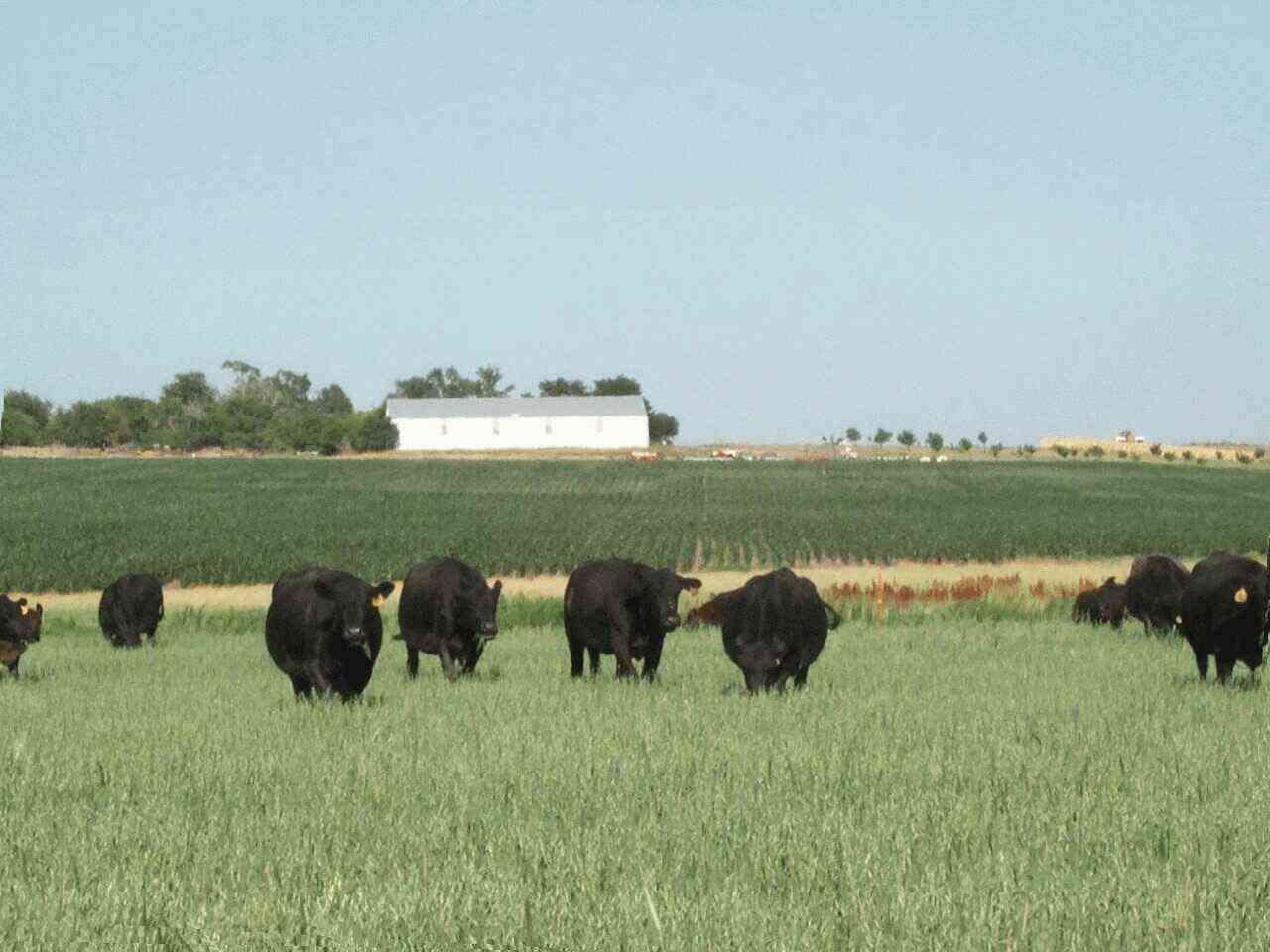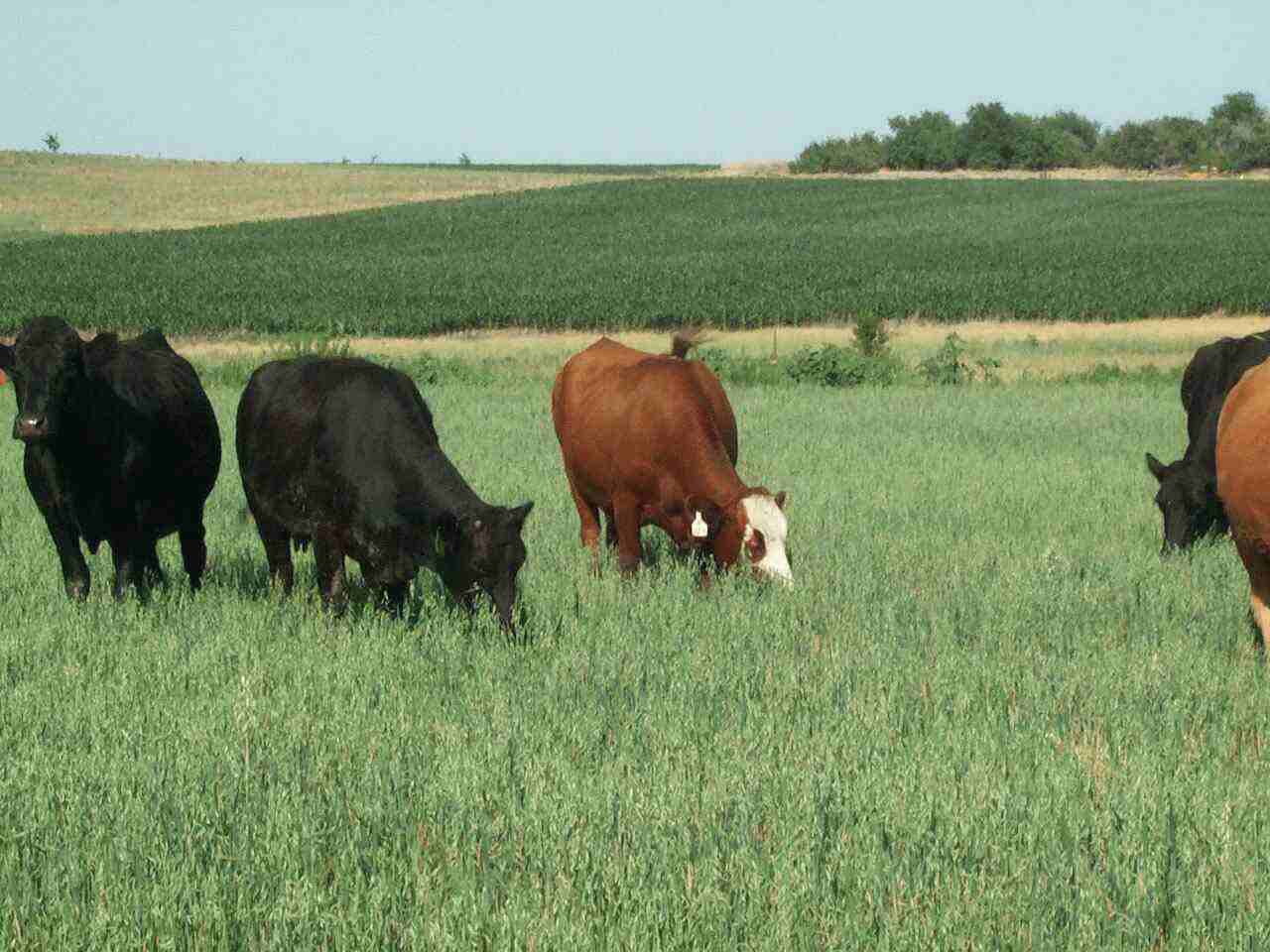Triangle H Farm
1999 Environmental Annual
Report
Document Links: Policy
/ Triangle H Environmental Aspects / Environmental Regulations / Action
Plan for 2000 / Contact information
Return to: IERE Home / IERE
Sustainable Agriculture Page
 The Hanson Family has been farming in Western Nebraska
for four generations now. We have special challenges in farming
here: the arid conditions mean that mostly dry-land crops are
raised. We also irrigate about 40 percent of the 1600 acres we
farm. It's what keeps us going in the dry years when annual rainfall
can fall below 6 inches.
The Hanson Family has been farming in Western Nebraska
for four generations now. We have special challenges in farming
here: the arid conditions mean that mostly dry-land crops are
raised. We also irrigate about 40 percent of the 1600 acres we
farm. It's what keeps us going in the dry years when annual rainfall
can fall below 6 inches.
Over the years, we have been farming in
a pretty conventional fashion: lots of chemicals, just a few crop
types, and a fair amount of cultivation. Recently, we have begun
to realize that we could farm in a more environmentally-friendly
manner, increase the diversity of our crops and use less chemicals.
We've begun raising cattle on our land, grazing them on a mix
of grasses, turnips and legumes. It is a long road we have to
walk, but we are taking the first steps.
 We are working with
the Institute for Environmental Research and Education (IERE).
to develop our environmental management plan. The plan will move
us towards sustainable agriculture, through annual planning based
on life cycle assessment.
We are working with
the Institute for Environmental Research and Education (IERE).
to develop our environmental management plan. The plan will move
us towards sustainable agriculture, through annual planning based
on life cycle assessment.
The main thing is that we are using the
international standards on environmental management systems (ISO
14000 ) to develop our farm plan. We are working towards improving
our performance, and part of that work is shown in this report.
The first step is to have a policy for environmental
improvement, one that states what our intentions are and how we
plan to get there.
Policy
Triangle H Farm is committed to sustainable
agriculture. We move towards this goal through a comprehensive
environmental farm plan, which evaluates environmental impacts
annually using life cycle assessment. Based on the life cycle
assessment, Triangle H will take action to continually improve
the environment both on and off-farm. As a baseline, Triangle
H complies with all applicable environmental regulations, and
practices pollution prevention, especially with respect to pest
management. Triangle H works hard to achieve a level of stewardship
of the land that conserves resources and protects biodiversity
values.
Jim Hanson
Farmer/Owner
We haven't yet completed
our life cycle assessments for our products (which are beans,
grains and beef), so we are working on improving the environment
on the farm using what we know about the environmental aspects
of our farming. The list below shows what those aspects are, what
impacts they may cause, and how they are linked to farming.
Triangle H Environmental
Aspects
|
Environmental Aspect |
Environmental. Impacts |
Significant? |
Related Activity |
|
Use of diesel |
Fossil fuel depletion |
Yes |
Running tractor |
|
Use of electricity |
Fossil fuel depletion; Air pollution |
yes |
Running water pumps |
|
Use of water |
Water resource depletion |
maybe |
Watering cattle, irrigation |
Use of pesticides
(should list separately) |
Air & water toxicity;
Biodiversity loss |
yes |
Control weeds in corn field
Control corn cut worm
Control flies on livestock
Other? |
|
Seed treatments |
" |
" |
|
|
Lasso Atrazine |
" |
" |
Control weeds in corn field |
|
Kernel Guard |
" |
" |
Control fungus on corn |
|
Fulltime (qts/acre) |
" |
" |
Control insects on corn |
|
Clarity (oz/acre) |
" |
" |
Control weeds on corn field |
|
Lorsban (gal/acre) spray |
" |
" |
Control fungus on corn |
|
Roundup (oz/acre) spray |
" |
" |
Control weeds in wheat |
|
Musk thistle stuff |
" |
" |
Control musk thistle |
|
Use of nhydrous ammonia |
Global warming
biodiversity loss
Eutrophication |
yes |
Use on corn |
|
Use of nitrogen fertilizer |
Same |
yes |
Use on corn |
|
Use of phosphate fertilizer |
Eutrophication |
maybe |
Grow crops |
|
Manure reduction |
Odor; eutrophication |
no |
Grow beef cattle |
|
Manure distribution |
Odor; eutrophication |
no |
As fertilizer |
|
Cow access to streams |
Loss of biodiversity |
yes |
Herding cattle/control |
|
Cultivating |
Loss of biodiversity
Soil loss; Fossil fuel consumption;
Air pollution |
yes |
Weed control |
Environmental
Regulations
Since we do use pesticides, we have to follow
the EPA regulations about their use. Most times, we hire the spraying
done, but Jim Hanson is also certified for the application of
pesticides. To the best of our knowledge, we are in full compliance
with the requirements of FIFRA The Federal Insecticide, Fungicide
and Rodenticide Act.)
 Action Plan for 2000
Action Plan for 2000
In 1999, we began using intensive crop grazing
as a method to decrease our environmental impacts. What this means
is that we bought cattle, and rather than harvesting corn and
sending it to a grain elevator, we allowed the cattle to graze
in the cornfield. We also planted rye and turnips as a source
of winter grazing for the cattle. The environmental outcome of
this method of farming is that we decreased the need for fertilizer
and pesticides, as well as diesel for running the tractors.
In 2000, we are expanding our grazing program.
We have more cattle, and a new crop of calves. We'll be grazing
more land and start planning the return to native pasture.
In addition, we will be fencing the freshwater
lagoon on the property. Although it is only about 6 or 7 acres,
it provides habitat for migrating waterbirds. The farm is in the
central flyway and we get many bird visitors in the Spring and
Fall. Fencing will be important now that we have cattle on the
property.
Finally, by year end will have collected
all the information we need to do a life cycle assessment.
Contact information
Tom Hanson
402-489-0988
thomas.hanson@mciworld.com
This project was funded, in part,
by the U.S. EPA with funds administered by American
Farmland Trust.
 The Hanson Family has been farming in Western Nebraska
for four generations now. We have special challenges in farming
here: the arid conditions mean that mostly dry-land crops are
raised. We also irrigate about 40 percent of the 1600 acres we
farm. It's what keeps us going in the dry years when annual rainfall
can fall below 6 inches.
The Hanson Family has been farming in Western Nebraska
for four generations now. We have special challenges in farming
here: the arid conditions mean that mostly dry-land crops are
raised. We also irrigate about 40 percent of the 1600 acres we
farm. It's what keeps us going in the dry years when annual rainfall
can fall below 6 inches. We are working with
the Institute for Environmental Research and Education (
We are working with
the Institute for Environmental Research and Education ( Action Plan for 2000
Action Plan for 2000